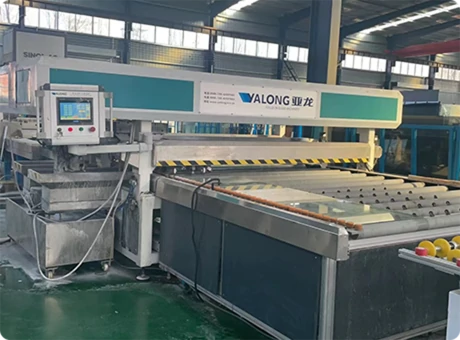The Fluctuating Landscape of Float Glass Prices
Float glass has become an indispensable material in a variety of industries, including construction, automotive, and electronics, thanks to its clarity, smooth surface, and versatility. However, like most commodities, the price of float glass is subject to variation due to multiple factors. Understanding these dynamics can help businesses and consumers strategize their purchasing and investment decisions more effectively.
Understanding Float Glass
Float glass is produced through a process known as the float glass process, where molten glass is floated on molten tin to create a smooth and uniform sheet. This method yields glass with minimal distortion, making it ideal for applications such as windows, mirrors, and other architectural features. The glass industry has seen significant advancements in technology, improving the efficiency of production and the quality of the product. However, the cost of raw materials and energy has a profound impact on the final price of float glass.
Factors Influencing Float Glass Prices
1. Raw Material Costs The primary ingredients for producing float glass include silica sand, soda ash, and limestone. Fluctuations in the prices of these materials can significantly affect the cost of float glass. For instance, silica sand prices have been on the rise due to environmental regulations and depletion of high-quality deposits.
2. Energy Prices The production of float glass requires substantial energy, primarily in the form of electricity and natural gas. Hence, any change in energy prices directly influences production costs. Recent rises in global energy prices, exacerbated by geopolitical tensions and supply chain disruptions, have led to higher production costs for float glass manufacturers.
3. Demand and Supply Dynamics The demand for float glass is intrinsically tied to the construction and automotive sectors. A surge in construction activities, such as new buildings and renovation projects, typically leads to increased demand for float glass. Conversely, an economic downturn can lead to reduced demand, instigating a drop in prices. Furthermore, the supply side is equally critical; if manufacturers are unable to keep up with demand due to production constraints or logistical issues, prices may surge.
float glass price
4. Market Competition The float glass market is increasingly competitive, with numerous players vying for market share. Competitive pressures can lead to price wars, which may benefit consumers in the short term. However, chronic underpricing can undermine the financial viability of manufacturers, which could have longer-term ramifications on quality and supply stability.
5. Technological Advancements Innovations in production technologies can lead to more efficient manufacturing processes. Companies investing in advanced technologies may ultimately lower production costs, allowing them to pass savings onto consumers. This factor can create fluctuations in pricing as new technologies are adopted at different rates by various manufacturers.
Recent Trends in Float Glass Prices
In recent years, the float glass market has experienced notable volatility. For instance, after the onset of the COVID-19 pandemic, many construction projects were halted, leading to a brief dip in demand and prices. However, as economies reopened, a pent-up demand surged, causing prices to rise sharply in 2021 and 2022.
Additionally, the effects of climate change have prompted a shift toward more sustainable building materials, with many industries moving to recyclable options, which also affects float glass demand and pricing.
Conclusion
The price of float glass is influenced by a complex interplay of raw material costs, energy prices, market demand, competition, and technological advancements. For consumers and manufacturers alike, staying informed about these factors can provide valuable insights into the float glass market. As the industry continues to evolve, those who navigate these fluctuations effectively will be better positioned for success in this vital sector. Understanding the drivers of float glass prices is not just a matter of financial planning; it’s a strategic imperative in a rapidly changing economic landscape.
 Afrikaans
Afrikaans  Albanian
Albanian  Amharic
Amharic  Arabic
Arabic  Armenian
Armenian  Azerbaijani
Azerbaijani  Basque
Basque  Belarusian
Belarusian  Bengali
Bengali  Bosnian
Bosnian  Bulgarian
Bulgarian  Catalan
Catalan  Cebuano
Cebuano  Corsican
Corsican  Croatian
Croatian  Czech
Czech  Danish
Danish  Dutch
Dutch  English
English  Esperanto
Esperanto  Estonian
Estonian  Finnish
Finnish  French
French  Frisian
Frisian  Galician
Galician  Georgian
Georgian  German
German  Greek
Greek  Gujarati
Gujarati  Haitian Creole
Haitian Creole  hausa
hausa  hawaiian
hawaiian  Hebrew
Hebrew  Hindi
Hindi  Miao
Miao  Hungarian
Hungarian  Icelandic
Icelandic  igbo
igbo  Indonesian
Indonesian  irish
irish  Italian
Italian  Japanese
Japanese  Javanese
Javanese  Kannada
Kannada  kazakh
kazakh  Khmer
Khmer  Rwandese
Rwandese  Korean
Korean  Kurdish
Kurdish  Kyrgyz
Kyrgyz  Lao
Lao  Latin
Latin  Latvian
Latvian  Lithuanian
Lithuanian  Luxembourgish
Luxembourgish  Macedonian
Macedonian  Malgashi
Malgashi  Malay
Malay  Malayalam
Malayalam  Maltese
Maltese  Maori
Maori  Marathi
Marathi  Mongolian
Mongolian  Myanmar
Myanmar  Nepali
Nepali  Norwegian
Norwegian  Norwegian
Norwegian  Occitan
Occitan  Pashto
Pashto  Persian
Persian  Polish
Polish  Portuguese
Portuguese  Punjabi
Punjabi  Romanian
Romanian  Russian
Russian  Samoan
Samoan  Scottish Gaelic
Scottish Gaelic  Serbian
Serbian  Sesotho
Sesotho  Shona
Shona  Sindhi
Sindhi  Sinhala
Sinhala  Slovak
Slovak  Slovenian
Slovenian  Somali
Somali  Spanish
Spanish  Sundanese
Sundanese  Swahili
Swahili  Swedish
Swedish  Tagalog
Tagalog  Tajik
Tajik  Tamil
Tamil  Tatar
Tatar  Telugu
Telugu  Thai
Thai  Turkish
Turkish  Turkmen
Turkmen  Ukrainian
Ukrainian  Urdu
Urdu  Uighur
Uighur  Uzbek
Uzbek  Vietnamese
Vietnamese  Welsh
Welsh  Bantu
Bantu  Yiddish
Yiddish  Yoruba
Yoruba  Zulu
Zulu 

